Many parents, when buying a bike for the kids, make several mistakes. From wrong size and model of a bicycle (this will be addressed in separate posts), to the insisting on training wheels. This post will explain why training wheels are not good for learning to ride a bicycle and what is the easier way.
As was explained (in detail and length) in the post about “counter-steering“, a bicycle needs active balance control in order to stay upright. It also needs to be leaned in a corner in order to turn efficiently at almost any speed higher than the walking speed. Both these things are practically hampered by training wheels. How so?
First: a bike with training wheels stays upright without any balance input from the rider. This way kids aren’t stimulated to learn how to balance a bicycle.
Second: training wheels make any useful amount of leaning into a corner impossible.
Third, related to the previous two: leaning a bike in a corner is best done by first turning the bars in the opposite direction. Training wheels (and any tricycle) teaches the kids the opposite technique – to turn the bars where they want to go from the start.
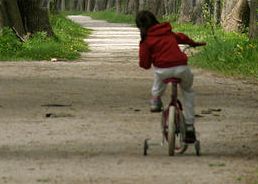
Picture 1
As can be seen in picture 1, child’s body is leaned into the corner substantialy, because the training wheels prevent leaning the bike into the corner. Speed needs to be very low, or even the substantial body leaning will not be able to prevent the bike from tipping to the opposite side, because of the centrifugal force.
Proper cornering, with leaning the bike and body in line with the (leaned) bike is shown in the picture 2.
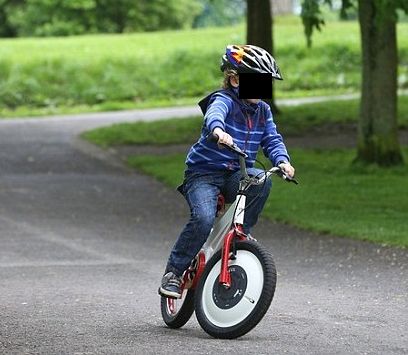
Picture 2
How can a child, without (obstructions by) the training wheels, learn how to balance and ride a bicycle? The best solution is a balance bike, shown in picture 3.
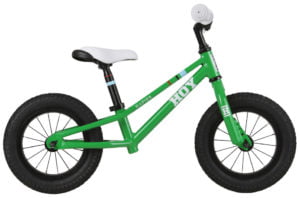
Picture 3
Balance bike is a bicycle without pedals, with the frame constructed so that it enables lowering the saddle enough that the child can comfortably reach the ground with both feed while seated and push off to go. This way, child easily achieves higher speeds, while legs are always there in case it looses the balance. It will, by itself, instinctively, rather quickly (often within couple of hours, or less) learn how to keep the balance while the bicycle rolls, with legs raised up. Same goes for turning (cornering) and leaning while doing it.
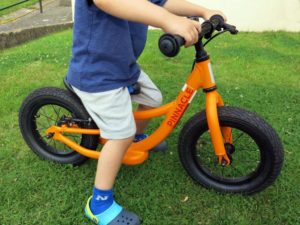
Picture 4
Video explaining how to quickly and easily learn to ride a bicycle (for both kids and adults):

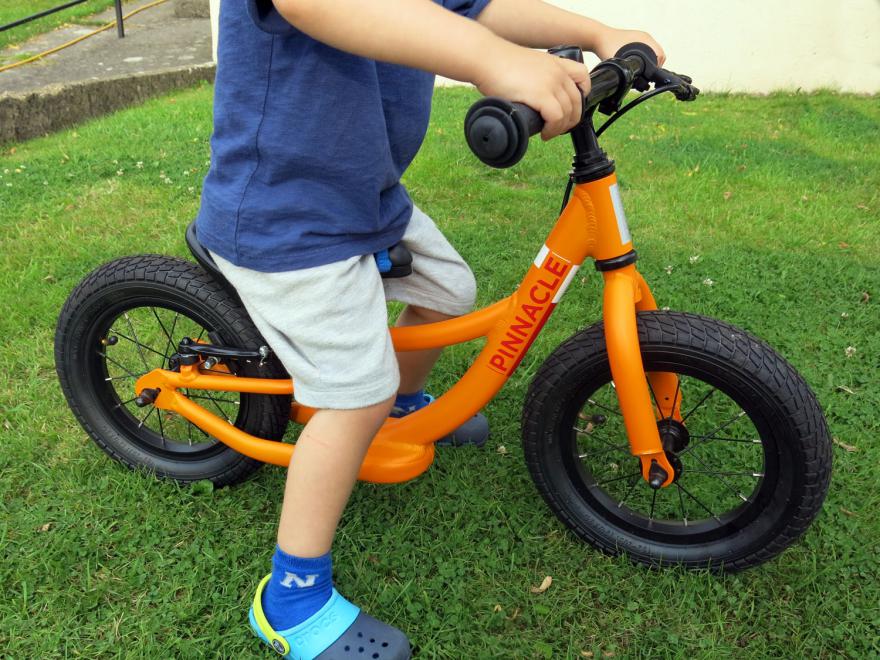
Hello! This is a request for help.
I searched your website for Balance bikes and found this thread.
From the request in a comment I left on bikeforums.net (my username is saucerdesigner) under General Cycling Discussion> Balance/Strider Bikes:
” Wheel and Hub dimensions for 12″ balance bikes
I’m wanting to design a variant of a 12″ balance bike wheel and hub to be made completely of carbon fiber, with steel ball bearings, except it won’t be used in a bicycle. It will be used to mount a high-speed fan in an experimental scale model VTOL aircraft prototype of my own design.
1.Where can I find the dimensions of such a hub?
2. Can spokes for 12″ wheels for balance bikes be made from carbon fiber?”
====================================================================
I was offered a suggested website where I could purchase complete CF wheelsets for Balance/Strider bikes which are too heavy for my purpose.
This variant will have to be ultra light; it will not have a bicycle rim; it will have only 12″ balance bike’s hub and spokes and a custom rim comprised of a CF right-circular cylinder, say, 3/4″ high, having the inside diameter of a 12″ rim and an integral or separate but joined CF annulus for mounting a high-speed rotor. The cross-section of the rim would resemble the cross-section of a piece of 3/4″ x 3/4″ angle.
If I can obtain the dimensions of the hub and the inside diameter of the rim, then I can proceed to generate a 3D CAD model to provide to custom CF bicycle wheel builders here in the US to make my rotor mount.
Any help you can offer will be greatly appreciated.
Thank you.
Hi David,
Short answer:
I don’t know.
Long answer – some ideas to consider:
Apologies in advance for the Tarzan-English. 🙂
I’ll start with a disclaimer – I’m not a mechanical engineer. However, as far as I know, bicycle wheels might not be properly designed for your intended use. Why?
Now a small digression – I believe you’ve taken this into account, but want to be certain:
Bike wheels need to take tyres – more than one mounting and dismounting of them.
Tyres are pumped to a certain pressure, so rims are designed to stand that as well.
They also must take vertical, and some side loads. Loads of the rider and bicycle mass are effectively multiplied when bumps and potholes are hit.
Wheel bearings, on the other hand, needn’t take too many rpm-s.
The same goes for wheel balancing – unlike with cars, bicycle wheels don’t spin that fast.
So I’m not really sure if a bicycle wheel is a good design to start with, for your intended purpose.
Light components that come to mind:
Polymer ultra-light spokes.
I don’t know where carbon fiber spokes can be bought. Some road bike wheels are made with such spokes, but I don’t know about spare spokes.
Challenges faced here are hub to spoke interface (usually designed for spokes that aren’t bent at the elbow), and finding a way to tighten the spoke – metal threads are usually fixed/glued to the end of the spoke.
This is a relatively light hub, that could take polymer spokes, but not carbon fiber spokes (it requires spokes that can be bent at the elbow):
https://www.enve.com/product/carbon-hub/
If your construction won’t be taking much torsion loads or vertical loads, you could go with few spokes, and lace them radially (not interlaced, but straight from the hub towards the “rim”).
That could help save some weight.
You could also design your own “hub” – picking the smallest & lightest cartridge bearings that are strong enough for your intended purpose.
There are angular contact cartridge bearings, in case your design takes some sideways loads, along with the radial loads, but I’m not sure those are perfect for very high rpm applications (again, I’m not a mech. engineer).
Depending on the loads, you could “get away” with as few as 8 spokes, just to keep the “rim” centred.
I fear that most wheels that are factory built will be too heavy, too strong for the intended purpose. Especially the 12″ ones.
With 28″ road bicycle front wheels, the situation might be better – they do make some that are too weak, too light, to be ridden (with carbon spokes breaking on the riders), so with such a large diameter, very light versions are available (of course, such wheels will still be heavier than light 12″ wheels).
Relja
Hi Relja,
Thank you for your response.
I’m thinking I’m going to have to buy a 12″ wheel and hub just to reverse engineer the hub and make my own out of carbon fiber.
The application is for a scale-model proof-of-concept prototype aircraft so in flight and while maneuvering there will be gyroscopic precession forces on the mount of the rotor to consider. Thankfully the rotor and it’s mount (the variant of a bicycle wheel) will be as light as I can possibly make them. I’m going to go with metal spokes for the sake of convenience on the original prototype.
Believe me, if there was another way of mounting the rotor I would go for it in a heartbeat to avoid the spokes, motor and gearing interfering with the flow of air into the rotor.
The link you provided for “…a relatively light hub, that could take polymer spokes…” took me to the same website as the link for Polymer ultra-light spokes, so if you could send me the correct link for the hub I would appreciate it.
Here’s a link to an article featuring the producer of braided carbon fiber spokes btw:
https://bikerumor.com/2020/07/08/gulo-composites-launches-with-braided-carbon-spokes-on-nc-built-carbon-wheels/
Hi David,
I’ve edited the original reply – but just in case, here’s the link again:
https://www.enve.com/product/carbon-hub/
I don’t know of any lighter hubs – whether front, or rear.
Relja
Hi Relja,
Awesome!
Thank you.
David